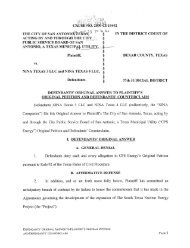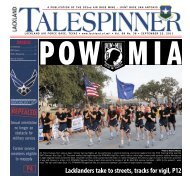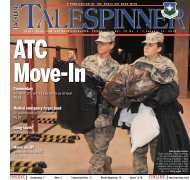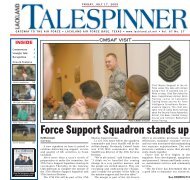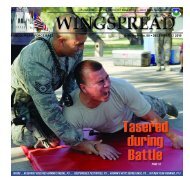April 19, 2013 - San Antonio News
April 19, 2013 - San Antonio News
April 19, 2013 - San Antonio News
- No tags were found...
You also want an ePaper? Increase the reach of your titles
YUMPU automatically turns print PDFs into web optimized ePapers that Google loves.
PAGE 8By Chanel WeaverArmy Public Health Command Public AffairsNational Prescription Drug Take-Back Day will be observed locally andnationwide <strong>April</strong> 27.Sponsored by the Drug EnforcementAdministration, the day isspecifically set aside to allow an opportunityto empty medicine cabinets,kitchen drawers, purses andpillboxes of unwanted, unused andexpired prescription drugs, and takethem to authorized collection sites inlocal communities.Brooke Army Medical Center willhave two locations to turn in prescriptiondrugs from 10 a.m. to 2 p.m. Thefirst is at the <strong>San</strong> <strong>Antonio</strong> MilitaryMedical Center medical mall area andalso at the Joint Base <strong>San</strong> <strong>Antonio</strong>-Fort Sam Houston Refill Pharmacy,located in Building 2401 on Scott andHarney Roads.At JBSA-Lackland, people can dropoff these items from 10 a.m. to 2 p.m.at the Wilford Hall Ambulatory SurgicalCenter Satellite Pharmacy, locatedbetween the main base exchangeand the commissary.At JBSA-Randolph, turn in unwantedprescription drugs from 10a.m. to 2 p.m. <strong>April</strong> 27 at the mainbase exchange satellite pharmacy,Building 1040, in the BX mall area.There will be certified law enforcementpersonnel physically present atthe drop-off locations for the durationof National Prescription Take-BackDay activities, per DEA protocolsDrug overdoses and brain damagelinked to long-term drug abuse killedan estimated 37,485 people in 2009,the latest year for which preliminarydata are available, according to a reportby the Centers for Disease Controland Prevention.“Drugs now kill more people thanmotor vehicle accidents in the U.S.,”said Maj. Clifton Dabbs, a physicianand epidemiologist at the U.S. ArmyPublic Health Command.Prescription drug use has increasedover the years in the military. About17 percent of military personnel reportedmisusing prescription drugs,including stimulants (other than methamphetamine),tranquilizers/musclerelaxers, sedatives/barbiturates, painrelievers, anabolic steroids, and erectiledysfunction drugs, according to the2008 Department of Defense Survey ofHealth-Related Behaviors.As in the civilian population, painrelievers were the most commonlymisused/abused type of prescriptiondrug across the military services andin the Army specifically.According to the 2011 SubstanceAbuse and Mental Health Services Administration’sNational Survey on DrugUse and Health, more than 70 percentof people abusing prescription painrelievers got them through friends orrelatives, a statistic that includes raidingthe family medicine cabinet.Dabbs said that the abuse of opiatesis becoming more prevalentacross the Army.“Our surveillance shows that thereis a rapid increase in the numbers ofSoldiers being diagnosed with opiatedependence or abuse since 2005,”said Dabbs.Opiate drugs are narcotic sedativesthat depress activity of the centralnervous system, reduce pain andinduce sleep. When misused, opiatescan become deadly.“Opiates act centrally on the nervousWINGSPREADsystem and can actually suppress yourability to breathe,” said Dabbs.For this reason, it is important to getrid of painkillers as soon as possible.“It is highly recommended to flush anynarcotic pain killer down the toilet whenthey are no longer needed for the treatmentof pain in which they were prescribed,”said Dabbs. “This is becausethe risk of someone stealing them, takingthem by accident, and or the temptationto use them recreationally when drinkingis too high and the consequences can bedeadly,” said Dabbs.While flushing is not a recommendeddisposal method for many drugs, Dabbs’advice about opiates is seconded by authoritiessuch as the Food and Drug Administration.Dabbs also pointed out that drugs canlose potency and effectiveness if they arestored improperly or kept too long.Since the opportunity to dispose of unwantedand expired medications comesaround only once a year, Dabbs thinks it’san opportunity that should be seized.“In the interests of both health andsafety, it’s best to rid homes and barracksof unneeded prescriptions,” Dabbs said.“Disposing of old prescriptions throughAPRIL <strong>19</strong>, <strong>2013</strong>JBSA locations observe Prescription Drug Take-Back Day <strong>April</strong> 27“In the interests of bothhealth and safety, it’sbest to rid homes andbarracks of unneededprescriptions. Disposing ofold prescriptions throughthe take-back programremoves the risk ofmisuse and precludesaccidental overdose bychildren or pets.”Maj. Clifton DabbsU.S. Army Public Health Commandphysician and epidemiologistCourtesy graphicthe take-back program removes the riskof misuse and precludes accidental overdoseby children or pets.”For personnel who are unable tovisit an authorized collection site, theFood and Drug Administration recommendsdisposing of prescription medicationby taking the medication out ofits original container and mixing withkitty litter or used coffee grounds, thendouble bagging the item, and puttingout with the trash.Past Prescription Drug Take Back-Days have been very successful, accordingto the DEA. More than 488,000pounds of unwanted or expired medicationwas collected at 5,263 takebacksites Sept. 29.For more information on NationalPrescription Drug Take-Back Day orto locate a local collection center, visitthe Drug Enforcement Administrationwebsite at http://www.deadiversion.usdoj.gov/drug_disposal/takeback/index.html or the Food and Drug Administrationwebsite at http://www.fda.gov/downloads/Drugs/ResourcesForYou/Consumers/BuyingUsingMedicineSafe-ly/UnderstandingOver-the-Counter-Medicines/ucm107163.pdf.





